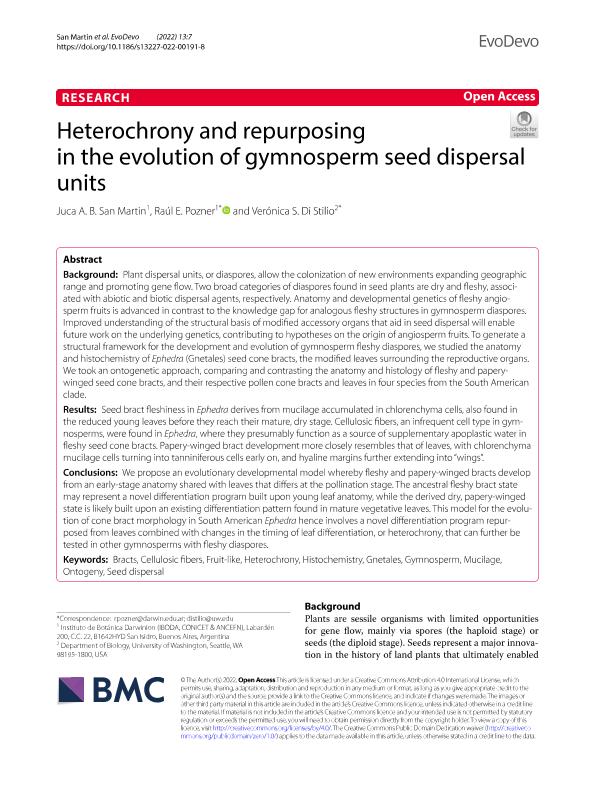Artículo
Heterochrony and repurposing in the evolution of gymnosperm seed dispersal units
Fecha de publicación:
02/2022
Editorial:
BioMed Central
Revista:
EvoDevo
ISSN:
2041-9139
Idioma:
Inglés
Tipo de recurso:
Artículo publicado
Clasificación temática:
Resumen
Background: Plant dispersal units, or diaspores, allow the colonization of new environments expanding geographic range and promoting gene flow. Two broad categories of diaspores found in seed plants are dry and fleshy, associated with abiotic and biotic dispersal agents, respectively. Anatomy and developmental genetics of fleshy angiosperm fruits is advanced in contrast to the knowledge gap for analogous fleshy structures in gymnosperm diaspores. Improved understanding of the structural basis of modified accessory organs that aid in seed dispersal will enable future work on the underlying genetics, contributing to hypotheses on the origin of angiosperm fruits. To generate a structural framework for the development and evolution of gymnosperm fleshy diaspores, we studied the anatomy and histochemistry of Ephedra (Gnetales) seed cone bracts, the modified leaves surrounding the reproductive organs. We took an ontogenetic approach, comparing and contrasting the anatomy and histology of fleshy and papery-winged seed cone bracts, and their respective pollen cone bracts and leaves in four species from the South American clade. Results: Seed bract fleshiness in Ephedra derives from mucilage accumulated in chlorenchyma cells, also found in the reduced young leaves before they reach their mature, dry stage. Cellulosic fibers, an infrequent cell type in gymnosperms, were found in Ephedra, where they presumably function as a source of supplementary apoplastic water in fleshy seed cone bracts. Papery-winged bract development more closely resembles that of leaves, with chlorenchyma mucilage cells turning into tanniniferous cells early on, and hyaline margins further extending into “wings”. Conclusions: We propose an evolutionary developmental model whereby fleshy and papery-winged bracts develop from an early-stage anatomy shared with leaves that differs at the pollination stage. The ancestral fleshy bract state may represent a novel differentiation program built upon young leaf anatomy, while the derived dry, papery-winged state is likely built upon an existing differentiation pattern found in mature vegetative leaves. This model for the evolution of cone bract morphology in South American Ephedra hence involves a novel differentiation program repurposed from leaves combined with changes in the timing of leaf differentiation, or heterochrony, that can further be tested in other gymnosperms with fleshy diaspores.
Archivos asociados
Licencia
Identificadores
Colecciones
Articulos(IBODA)
Articulos de INST.DE BOTANICA DARWINION (I)
Articulos de INST.DE BOTANICA DARWINION (I)
Citación
Abramo Barrera San Martin, Juca; Pozner, Raúl Ernesto; Di Stilio, Verónica Sandra; Heterochrony and repurposing in the evolution of gymnosperm seed dispersal units; BioMed Central; EvoDevo; 13; 1; 2-2022; 2-19
Compartir
Altmétricas




